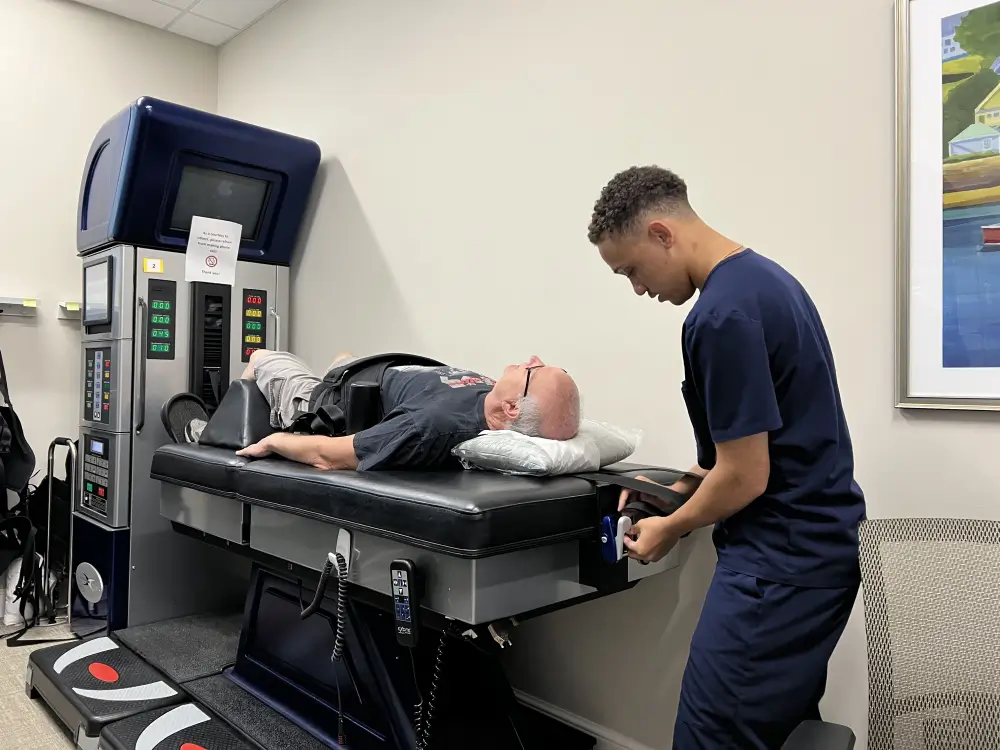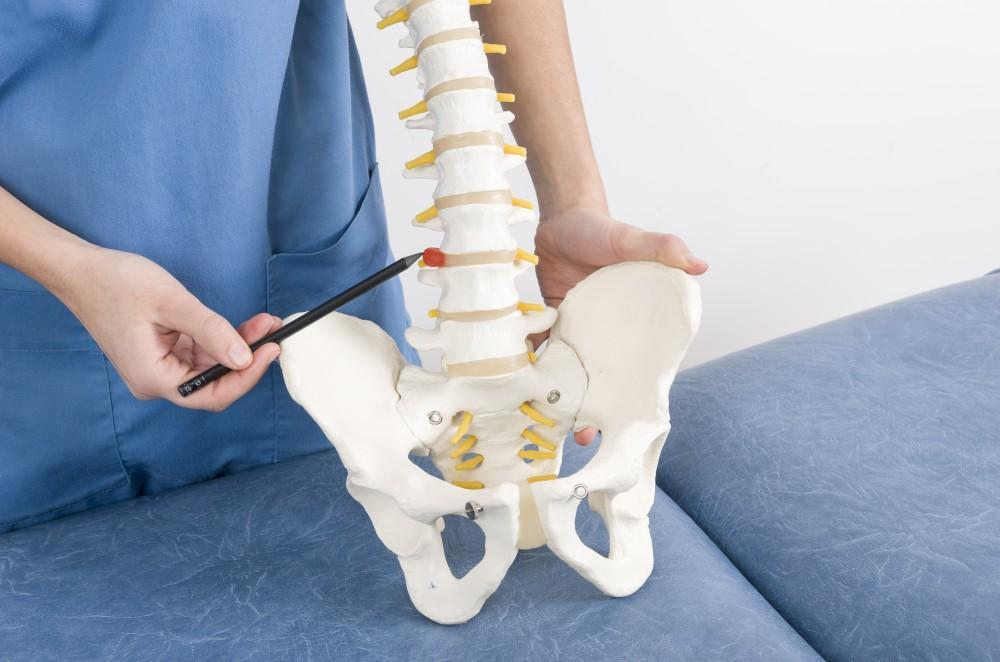Advanced Solutions for Spinal Compression, Herniated Discs, and Low Back Pain

We Would Love To See You As a New Patient
New Patient Special Offer:
Full Exam, Consultation, Evaluation, and First Care Session
Non-Surgical Spinal Decompression & Rehabilitation
Comprehensive Spinal Decompression Therapy
Extensive Range of Conditions Treated
- Chronic Back Pain: Targets underlying issues causing long-term back discomfort.
- Sciatica: Reduces pressure on the sciatic nerve caused by pinched nerves in the back.
- Herniated Discs: Helps return herniated material to a normal position within the discs.
- Degenerative Disc Disease: Promotes disc hydration to combat disc thinning or degeneration.
- Post-surgical Pain: Aids in recovery and pain relief post-spine surgery.


No Downtime, No Pain, No Discomfort
Disc Injury Treatment
Recognizing Disc Injury Symptoms
- Pain: Sharp or aching pain radiating to extremities.
- Muscle Spasms: Often due to nerve pressure from the herniated disc.
- Numbness & Tingling: A pins-and-needles sensation due to nerve compression.
Common Disc Injury Causes
- Repetitive Motion & Stress
- Heavy Lifting
- Auto Accidents
- Degenerative Disc Disease
- Degenerative Disc Disease
- Respiratory Illnesses
Our Approach to Lower Back Pain Relief
Advanced Spinal Decompression
Our approach to treating lower back pain is rooted in a combination of advanced medical techniques and personalized care. We believe in addressing the root cause of your pain rather than merely masking symptoms. Our team of experienced healthcare professionals works closely with each patient to develop customized treatment plans that target their specific needs and goals. By focusing on the underlying issues causing your pain, we aim to provide long-lasting relief and improve your overall well-being.
Recognizing Acute vs. Chronic Low Back Pain
- Acute Pain: Caused by a specific injury and typically surfaces within 72 hours.
- Chronic Pain: Persists for three months or more, often without a clear origin.
Common Causes of Lower Back Pain
- Bulging Lumbar Discs: Pressure from the disc nucleus causes a bulge, pressing on nerves and causing pain.
- Herniated Discs: When the disc nucleus escapes through the outer layer, causing more intense leg pain.
- Degenerative Disc Disease: Age or stress leads to disc dehydration, shrinking the space between vertebrae.
- Muscle Strain: Sudden movements or weak core muscles often cause dull, localized pain.
- Spinal Stenosis: Narrowing of the spinal canal leads to nerve pressure, aggravated by standing or walking.
- Facet and Sacroiliac Joint Dysfunction: Issues with these joints can result in significant low back pain.
- Subluxation: Misaligned vertebrae put pressure on spinal nerves, requiring chiropractic adjustments.

Sciatica Treatment in Stuart, FL
Our holistic chiropractic approach is non-invasive, addressing the injury’s root cause to enhance natural healing. By focusing on the whole body, we also offer guidance on lifestyle modifications to support recovery.
Common Causes of Sciatica
- Herniated Discs: A herniated disc occurs when the soft inner material of the disc pushes out through its outer layer, putting pressure on nearby nerves, including the sciatic nerve. This can lead to sharp, radiating pain down one leg, often accompanied by tingling or numbness.
- Spinal Stenosis: Spinal stenosis refers to the narrowing of the spinal canal, which can compress the nerves within. This condition is often due to age-related changes and can lead to sciatica pain that radiates from the lower back to the legs.
- Piriformis Syndrome: The piriformis muscle, located in the buttocks, can sometimes spasm or become tight, pressing against the sciatic nerve and causing pain. This syndrome is more common in athletes and people who engage in activities that involve repetitive lower body movement.
- Spondylolisthesis: This condition occurs when one vertebra slips forward over the one below it, potentially compressing nerve roots and triggering sciatica.
- Injury or Trauma: Direct injuries to the lower back or pelvis, such as those from falls or accidents, can also compress the sciatic nerve and lead to sciatica symptoms.
Secure Your Spot!
1) Book your appointment now by filling out the form below and selecting an ideal day and time.
— OR —
2) Call our team now to schedule over the phone:
Back and Neck Pain
Back and neck pain, including chronic pain, can be treated effectively through disc decompression.
Herniated Disc
Disc decompression therapy creates negative pressure on the discs of the spine, effectively pulling them back into place.
Worn Spinal Joints
Also known as posterior facet syndrome, worn spinal joints have shown a reduction in symptoms with disc decompression.
Sciatica
Disc decompression can reduce compression of the Sciatic nerve and reduce symptoms of pain and spasms.
Degenerated Discs
By gently stretching the spine, disc decompression reduces symptoms of degenerative disc disease by reducing pressure in the spine.
Spinal Stenosis
Disc decompression is a non-invasive treatment proven effective at treating spinal stenosis and relieving symptoms.
Headaches
Through disc decompression, chiropractors can relieve pain and reduce the severity of chronic headaches.
Nerve Pain
Disc decompression therapy is used by chiropractors to relieve compression of the nerves, reducing pain and inflammation.

Dr. Bridget Hurley
DNP, APRN, FNP-C, RDMS

Dr. William Wiedner
D.C.
FAQ - Spinal Decompression Therapy
Spinal decompression therapy is a non-surgical treatment aimed at relieving back pain and promoting healing of the discs in the spine. This therapy gently stretches the spine, changing its force and position to help take pressure off spinal discs.
During spinal decompression, a traction table is used to apply controlled stretching of the spine. This stretching creates negative pressure within the disc, which can help reposition bulging or herniated discs and improve nutrient and oxygen flow to the disc.
Spinal decompression is effective for conditions such as herniated discs, sciatica, degenerative disc disease, pinched nerves, and chronic neck or back pain.
Most patients find spinal decompression therapy to be comfortable and relieving. Some may experience mild discomfort initially, but this typically subsides as the body adapts to the stretches.
Each session typically lasts about 30 to 45 minutes, depending on the specific needs of your condition.
The total number of sessions required varies based on your individual condition. Most treatment plans range from 12 to 20 sessions, spread over four to six weeks.
Spinal decompression is a safe procedure with minimal risks. However, it is not suitable for everyone, such as patients with severe osteoporosis, surgical spinal appliances, or certain types of cancer.
Often, spinal decompression therapy is part of a comprehensive treatment plan that includes physical therapy, exercises, and sometimes nutritional counseling to optimize recovery.
Wear comfortable, loose-fitting clothing that allows easy movement and access to the spine.
In many cases, spinal decompression therapy can reduce symptoms significantly and may help some patients avoid surgery. However, the effectiveness can vary based on the individual’s specific condition.
Many patients report significant improvement in their symptoms following a full course of therapy. Success rates can vary, but clinical studies and patient reports suggest high levels of effectiveness in reducing pain and improving quality of life.
A consultation with one of our specialists will help determine if spinal decompression therapy is suitable for you based on your medical history and spinal health.
These questions aim to address common concerns and provide clear, concise information to help potential patients feel more informed and comfortable with the idea of undergoing spinal decompression therapy.
Contact us
STUART
1411 SE Ocean Boulevard
Stuart, FL 34996
(772) 362-3977
